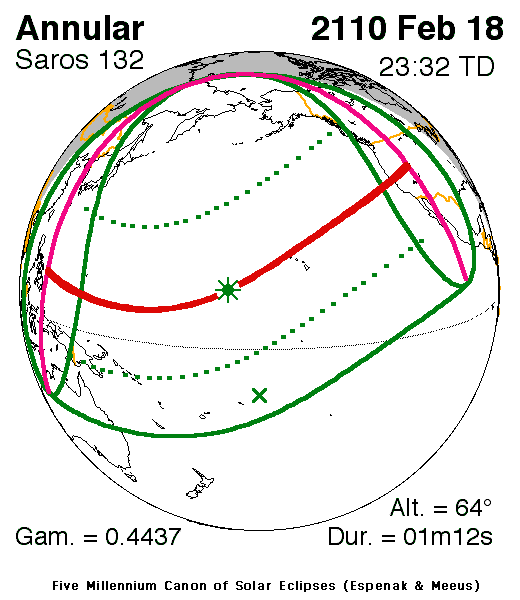An annular eclipse of the Sun occurs on Tuesday 18 February, 2110 UT, with maximum eclipse at 23:27 UT. A large annular eclipse will cover 99% of the Sun, creating a dramatic spectacle for observers in a narrow path at most 44 km wide; it will last 1 minute and 12 seconds at the point of maximum eclipse.
The annular eclipse lasts for 1 minute and 12 seconds.
Maximum eclipse is at 23:27:48 UT.
During this eclipse the Sun will be 0.540° in apparent
diameter, 1.2% larger than average. The Moon will be 5 days after perigee and 7 days before apogee.
At maximum eclipse it will be 0.534° in
apparent diameter, which is around average; this is not
large enough to cover the Sun, which is why this
is an annular eclipse.
The statistics page has information on the ranges of the sizes of
the Sun and Moon, and the Moon data page displays detailed
information on the Moon's key dates.
Overview Map
This map sourced from NASA Goddard Space flight Center: GSFC Eclipse Web SiteGSFC Eclipse Web Site
The primary source of all the information on eclipses presented here at Hermit Eclipse. (NASA Goddard Space flight Center)
shows the visibility of the annular solar eclipse. It also shows the broader area in which a partial eclipse will be seen. (Click on it for the
full-sized version.)
Eclipse Season and Saros Series
This eclipse season contains 2 eclipses:
This is the 51st eclipse in solar Saros series 132.The surrounding eclipses in this Saros series are:
This Saros series, solar Saros series 132,
is linked to lunar Saros series 125. The
nearest partner eclipses in that series are:
Eclipse Parameters
| UT Date/time (max) | 23:27:48 on 18 Feb UT |
TDT Date/time (max) | 23:31:35 on 18 Feb TDT |
| Saros Series | 132 |
Number in Series | 51 |
| Penumbral Magnitiude | |
Central Magnitiude | 0.9888 |
| Gamma | 0.4438 |
Path Width (km) | 44 |
| Delta T | 3m47s |
Error | ± 1m49s (95%) |
| Penumbral Duration | |
Partial Duration | |
| Total Duration | 1m12s |
| |
| Partial Rating | |
Total Rating | |
| Sun Distance | 147822343 km (15.0%) |
Moon Distance | 378727 km (44.4%) |
| Sun Diameter | 0.540° |
Moon Diameter | 0.526° - 0.534° |
| Perigee | 02:58 on 14 Feb UT |
Apogee | 15:26 on 26 Feb UT |
Note that while all dates and times on this site (except
where noted) are in UT, which is within a second of civil time,
the dates and times shown in NASA's eclipse listingsGSFC Eclipse Web Site
The primary source of all the information on eclipses presented here at Hermit Eclipse. (NASA Goddard Space flight Center)
are in the TDT timescale.
The Sun and Moon distances are shown in km, and as a
percentage of their minimum - maximum distances; hence 0%
is the closest possible (Earth's perihelion, or the
Moon's closest possible perigee) and 100% is
the farthest (aphelion, the farthest apogee).
The statistics page has information on the ranges of sizes
of the Sun and Moon, and the Moon data page displays detailed
information on the Moon's key dates.
Data last updated: 2015-06-21 22:11:46 UTC.

